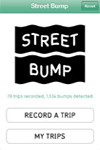Street Bump: Crowdsourcing Better Streets, but Many Roadblocks Remain

Boston’s Street Bump is an interesting effort at leveraging the collective intelligence of the crowd to improve road conditions but still faces many challenges in creating measurable value for and incentivizing users.
Nearly five years ago, Boston Mayor Thomas Menino set out to find a more efficient way to maintain the city’s roads by leveraging technology and the collective intelligence of the crowd. The result was “Street Bump,” a smartphone app launched by the Mayor’s Office of New Urban Mechanics. Using a smartphone’s accelerometer, the app senses when the user hits possible potholes. The app uses the smartphone’s GPS to record the location of each pothole and then transmits that data to the city’s database. The idea, in short, is to crowdsource information on road conditions from the city’s residents. While this information was already somewhat crowdsourced – numerous hotlines and websites already existed for drivers to report potholes – Street Bump was the first attempt to automate the reporting process and facilitate crowdsourcing of road conditions from a much greater portion of Boston residents.
The first iteration of the app, Street Bump 1.0, however, did not function up to par. It couldn’t distinguish between potholes and other bumps or movement and gave too many false positives. Instead of giving up on this crowdsourcing innovation, The City of Boston sought a way to improve the app – by crowdsourcing a solution. The Mayor’s office turned to Innocentive, a firm that crowdsources innovative solutions from its global network of over 365,000 “registered solvers”. Innocentive hosted a contest to crowdsource the best solution for Street Bump, and Liberty Mutual donated $25,000 in prize money. The contest attracted more than 700 “solvers,” who came up with superior algorithms and mechanisms for detecting potholes. Three winners were selected, and Street Bump 2.0 incorporates elements from each of their solutions.
Although the Mayor’s Office of New Urban Mechanics still considers the project a work in progress, the Street Bump app has now been available for free download in the iTunes store for several years. Information on the progress of the Street Bump project is limited, but a recent article from Boston.com noted that of the 19,000 potholes reported in 2014, 16,000 of those were reported by city employees.[1] The data seems to suggest that Street Bump has not gained much traction among Boston residents – a result that I find unsurprising for multiple reasons. First, the Street Bump is tedious to use. After downloading the app, users must choose to “Record a Trip” each time they get in their car, and at the end of the trip, they must choose to “End Trip and Upload.” This in itself is enough to prevent most from using the application. Secondly, Street Bump cannot run in the background, meaning users cannot access other apps while they are recording a trip.[2] These requirements alone severely limit the appeal of Street Bump. It is possible, however, that advancements in the technology may eventually allow Street Bump to run in the background, and perhaps to even automatically record trips. Still, I believe the project will face challenges in gaining users given the lack of incentives. As of now, the project relies on residents uploading trips simply as good citizens. Street Bump’s value creation lies in its potential to improve road conditions for Boston residents, but given how difficult it is for residents to see measurable improvement, this value creation alone may not be enough. I suggest that the City of Boston find ways to incentivize users by adding gaming elements to Street Bump – for example, points or prizes could be awarded as trips are uploaded. Perhaps even a tax incentive could be offered for using the app.
Overall, Street Bump is a respectable effort at crowdsourcing information from drivers to improve road conditions, but it still faces many challenges. Most importantly, Street Bump must pursue technological advancements to improve ease of use and offer incentives to encourage more widespread adoption. I am hopeful that Street Bump may eventually help cities maintain their roads more economically, however, there is still much improvement to be made.
[1] Zie, Julie. “Reporting Potholes: There Are Too Many Apps For That.” Boston.com. January 22, 2015. http://www.boston.com/cars/news-and-reviews/2015/01/22/reporting-potholes-there-are-too-many-apps-for-that/fffZvt3LME056eBbSmDtEM/story.html



Cool idea! But I completely agree that it’s way too cumbersome for anyone to actually use at this point. What if they made an app that you installed on the tire of your car that automatically tracked your trips and sent road issues to the city? It doesn’t make sense to have the app on your phone for this sort of solution. But interesting idea to incentivize people with a tax break or point system. The tough part of this is there is no clear value-add for the users (unlike Waze – which shows people faster ways to drive, so they use the app and report traffic, etc.) – there is the long term benefit of improved roads, but that won’t remind me to employ the app each time I drive through Boston.